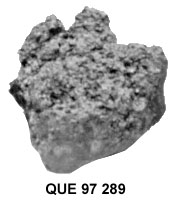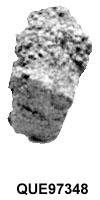
| MetSoc Home Publications Contacts |
 |
||
|
||
| Queen Alexandra Range 97289 | |||||||||||||||||||||||||
|---|---|---|---|---|---|---|---|---|---|---|---|---|---|---|---|---|---|---|---|---|---|---|---|---|---|
| Basic information | Name: Queen Alexandra Range 97289 This is an OFFICIAL meteorite name. Abbreviation: QUE 97289 Observed fall: No Year found: 1997 Country: Antarctica [Collected by US Antarctic Search for Meteorites program (ANSMET)] Mass:  51.9 g 51.9 g | ||||||||||||||||||||||||
| Classification history: |
This is 1 of 6 approved meteorites classified as Aubrite-an. [show all] Search for other: Achondrites, Aubrites, Enstatite achondrites, and Enstatite-rich meteorites | ||||||||||||||||||||||||
| Comments: | Field number: 11541 | ||||||||||||||||||||||||
Writeup |
Writeup from AMN 22(2):
  Macroscopic Description: Kathleen McBride Thin Section (,2) Description: Tim McCoy
The section consists of mm-sized enstatite grains (Fs0.1), reasonably abundant (10% or more?) feldspar of variable composition (An4-35), Si-bearing metal (1.9 wt.% Si), Ti-bearing troilite, daubreelite, alabandite and schreibersite. The latter phases often occur as rounded enclaves in the enstatite. The meteorite is an unusual aubrite. It is similar in many respects to LEW 88055 (Casanova et al., 1993, LPSC XXIV, 259-260). | ||||||||||||||||||||||||
| Data from: MB84 Table A1 Line 327: |
|
||||||||||||||||||||||||
| Catalogs: |
| ||||||||||||||||||||||||
| References: | Published in Antarctic Meteorite Newsletter 22(2) (1999), JSC, Houston Published in Meteoritical Bulletin, no. 84, MAPS 35, A199-A225 (2000)
| ||||||||||||||||||||||||
| Photos: |
| ||||||||||||||||||||||||
| Geography: |
Statistics: This is 1 of 44543 approved meteorites from Antarctica (plus 3802 unapproved names) | ||||||||||||||||||||||||
| Proximity search: | |||||||||||||||||||||||||
| Crosslinks: |
This lists all records that are linked to this record and to each other.
| ||||||||||||||||||||||||
| Also see: |
This lists the most popular meteorites among people who looked up this meteorite.
| ||||||||||||||||||||||||
| Revision history: |
This lists important revisions made to data for this record.
| ||||||||||||||||||||||||